-
Posts
68 -
Joined
-
Last visited
Content Type
Profiles
Forums
Articles
Gallery
Downloads
Events
Posts posted by Corin
-
-
Yeah mate, that is a locally made Bulgin burner (actually on closer it looks like a copy of the Bulgin), pretty commonly used for prawn cookers, branding irons and the like. It should get your steel nice and red in the open air. I would not think it would draw enough primary air for forge work (where secondary air is starved by the nature of forge design.)
In short, they are a nice little burner, but this is not the best way to apply it. There is something you can try... its a bit radical as far as forges go, but not for this burners intended purpose, being an immersion tube heater in a prawn cooker but trying this should identify the issue.
Remove the burner from the forge, pull it back away, say 50 mm and just hold it there, blowing the flame into the forge, if the burner hole on the forge is big enough, (normally it would be 1.5 - 2 times the burner diameter, but try it anywhay) it will draw air around the flame as it enters the forge, allowing combustion to occur within the forge and not out the ends... by regulating the distance between the burner and the forge, you should be able to control what occurs. This will be more akin to how the burner is applied in immersion tube prawn cookers, where the flame only is blown into a reasonably long, normally bent pipe. whatever happens this is not the best burner for your job.
If this fails, take heaps of pictures and send to me, of all aspects of your build, alternatively, PM me I will give you some details, and we can meet up in Sydney, we will make it work.
To understand what is happening here, you need to know a little about how burners are designed. Primary air is the air drawn in at the jet, it is only a percentage of the air required to react with the gas (combustion) The rest of the air for combustion comes from the air around the burner port (where the flame sits). This is called the secondary air. If you do not have enough of either combustion will be incomplete, and occur where there is enough air. i.e. outside your forge.
With blown or large ported venturi burners (as you will see on most forges), you get plenty of primary air, and the need for secondary air is greatly reduced, hence you get combustion occurring at the burner nozzle inside the forge.
the flammability limits of propane are 2.4%-9.6% Gas to Air. That is to say, for best performance you need approximately 6% gas 94% air for best performance.
Hope I did not go to technical, try what I suggested and get back to me we will go from there.
There are other things that will influence this burners operation, what pressure are you running at?
Regards
Corin -
Do you have a plastic or wooden insert in that one to help keep the shape?
I normally just wet form the leather, though I have used liners...
G'Day Corin , firstly welcome ta the site .
Bung youse name inta this , also approx where you are , you never know , mite be another smith just around the cnr from you .
http://www.iforgeiro...6-oz-roll-call/
Also look inta this , MOONY's Get HAMMERED each " October " ( so far )
http://www.iforgeiro...ered-at-moonys/
28 th , 29 th , 30 , of October 2011 @ Braidwood NSW
Dale Russell
Hey Dale thanks for the invite, I have added myself to the role call! Braidwood sounds great I have been told about this event by quite a few of my customers. Maybe this year should be the year...
Hi Corin, welcome to the site. I,m not around the corner but I am down the road at Bowral. Great looking knives and great photos, I have never made a knife but it always amazes me how knife makers make the handles and blend them with the blade.
Cheers Ian
Ian, Pleased to meet a local! What sort of things do you make? -
Hi
I have been knifemaking for about 10 years, working in the gas industry, and fixing, sizing and selling forge burner for blackmiths, farriers and the like, I had plenty of people pushing me to get started with forging. A few Tafe courses (Richmond) later, and I have re-jigged my workshop to incorporate forging my own blades.
Here are some pictures of my knives here My link
If anyone needs help with gas forges, or other gas related questions, I may be able to assist, feel free to ask here
My link
or PM me.
I live in Picton NSW -
Thats a great question, and one probably better put to a combustion engineer! It is out of my league, however I can make the following points.
I am working off combustion engineering orifice sizing and capacity tables for propane. These do not go higher than 50 PSI, and have been in use and accepted virtually unchanged for 50 years. I am going to assume it may be close to the wire, but is not a significant issue.
In the industry I am only aware of supersonic flows and choked flows causing issues in relief valve applications, where inappropriate sizing and inappropriate pipe-away pipework can significantly reduce a relief valves capacity and lead to container failure. A little more exciting than my forge melting steel I have to tell you. We do make allowances for supersonic flows when designing relief valve systems. I do not fully understand the subject though to be honest. As I said, out of my league at the moment. -
sorry If I slip back into metric and other units during these posts, I am trying to keep to BTU Pounds, Feet, etc, but I work with all units of measure... and I do slip up occasionally. Happy to assist with conversions if you need 'em
-
One question regarding higher temps. You mentioned "high gas pressures". How high is high? I usually run around 8 psi for normal forging, and don't feel I get enough heat for effective welding, but have been reluctant to crank up the pressure too high. My forge is very similiar to yours, single burner, shell made from 20# tank, 2 inches of dura-blanket plus reflective coating (ITC100).
Also, on a different note, there has been a lot of interest in ribbon burners as of late. Can you comment on any experience you have had with those? Very interesting thread!!
Hi Mate,
I want to be really specific here, my experience is in repairing, servicing, trouble shooting, adjusting, and using gas burners. Not in designing them. I tried no less than 6 different burners in my forge (Because I could mainly) and quite a few different configurations also. I did not arrive at my burner through guess work or science, but testing, trial and error.
Great question, With my venturi and burner set up, things get excitingly hot at around 50-60 PSI. With a door reducer in place, you can get to welding heat at about 30 PSI, probably less but it take longer.
To give some science on this subject, With the same sized jet... Lets say a #65 Drill The difference in energy input is approximately double if the pressure is raised from 10 PSI to 50 PSI
To give you a really good answer to this question, find out some answers to as many of the following questions as possible, and I will run some comparative energy calculations and see where the differences lie, and maybe even a few things for you to try.
Can your regulator go higher?
What is the lowest ambient temperature in your area or shop?
What size cylinders are you using?
Do all of your components have a rated working pressure suitable for higher pressures?
What size Jet are you using?
Do you have good adjustment of primary air on your venturi?
Do you have a good well designed venturi? My link
What local requirements are in place regarding the pressures and approvals to home built appliances?
Regarding part 2 of your question I am very interested, do you have a link? I would love to take a look.
I'm currently running a blown forge (also made from a 20lb propane tank) and considering making an aspirated forge to get unplugged. I'm currently getting a bit more than 5h from a 20lb tank of propane.
Seeing as you have the same size forge, how long can you get out of a tank?
Another great question.
To start with, if I give two different drivers the same car, and tell them to drive until the tank is empty and see how far they get, one will always do better than the other. for example one may be a lead foot and drive around town taking off from every set of lights at top speed, the other may get on the freeway and cruise at a moderate speed.
My point is even if we had exactly the same forge our usage patterns will be different.
I have a main flame/pilot flame bi-pass system on my forge, when I walk away from it I knock a ball valve with my knee, and it drops back to a low capacity holding flame.
I also never run my tanks (2 manifolded) empty, at low capacity wetted surface area is also reduced and hence vaporisation capacity. In simple terms you are taking out more gas than the liquid can boil off. I am sure someone will ask about this at some point and I will give a better explanation then.
In short I don't have the actual usage data to give you.
There is still a good answer to your question. There is data available for gas consumptions through orifices at different inlet pressures. Lets take a closer look at my forge.
There are a lot of variables that will effect how much heat is retained in the forge. but these figures are straight out of combustion engineering sizing tables.
I have a #65 orifice, and operate between 10 and 50 PSI
At 10 PSI I am using 2 pounds per hour.
At 20 PSI I am using 2.8 pounds per hour
At 30 PSI I am using 3.4 pounds per hour
At 40 PSI I am Using 4 pounds per hour
At 50 PSI I am using 4.4 pounds per hour
I normally work around the 20-30 PSI mark for general forging. So if I was using one 20 pound cylinder around 6-7 hours... There is no way a 9kg at low capacity can vapourize this kind of quantity for sustained periods, 2 works better but really you want bigger cylinders and more. I don't forge for hours on end, and keep them topped up. That works for me.
Good insulation,good pressure with the blower and enough propane to burn.....how much is enough depends on the forge size and what is in the forge.
Ric
Your on the money there mate. I will check the video out a bit later...
When I relined one of my propane forges I doubled the kaowool thickness and soon learned that if I didn't ease it back it would cheerfully melt my steel at the same burner adjustments that would just get it hot for forging prior to the re-line. 2 factors: reduced volume and reduced heat loss.
That is a really good point well made mate, and what I was trying to get at earlier. Most good pottery kilns I work with get to 2370 F with smaller burners and having huge internal volumes. The difference is they don't have big holes in the side, and normally are insulated with 6" of wool. If I was going for efficiency I would have a look at kiln design... -
Thanks for the welcome guys, glad you like.
-
thanks,keep it coming.can you give more in fo on your burner dimentions ect thanks again
Sorry if I was not clear enough... 1" BSP short pattern inspirator, 1" (id) Schedule 80 tube 12" long threaded both ends (1" BSP) then a 1" to 1 1/2" 3000 LB reducing coupling... Thats pretty much it.
The part numbers for these items at Gameco in Milton
are
1" Insporator/venturi NGB-1
Reducing coupling PCP4025
Pipe... made to order in gameco NSW... by me funnily enough... -
I can attest that propane will absolutely get hot enough to melt steel. Albeit, my forge has a forced air burner, if you put enough BTUs in a small enough space you can melt refractory if it isn't rated high enough DAMHIK BTW, Welcome Corin
BTW, Welcome Corin 
Scott
Thanks for the Welcome, and everyone else who said that too for that matter.
LOL I have to either stop getting it so hot for the fun of it or find better refractory. I scored all my refractory for the pricely some of some help with a kiln burner, so until I run out care factor is zero....
My problem is usually I no time to experiment with these things. I have just a pile of steel that needs to be forged into something and a stack of bills that need to be payed.
I guess I am lucky... for a long time I have been paid to do it.... I do so love my job.
Corin: Your post mainly said that you were here to answer questions.......Sooooooo: How about some info on your atmospheric burner... Orifice size and mixing chamber design. Thanks so much... Eric Sprado
Ok... for my forge... with my exact setup the orifice size is a number 65 Drill. It was smaller before the rebuild, but worked differently after so I re-tuned it.
for the burner there are four key components,
Lets start with the venturi, it is the one that seams to be least understood, and really to the detriment of most forges. My advice is don't stuff around, buy a short pattern inspirator, they look so simple but if you don't get it right you are just wasting your time. a good venturi gives you a similar effect to a blower, but uses the energy of the gas entering at high velocity (pressure) to draw the air in.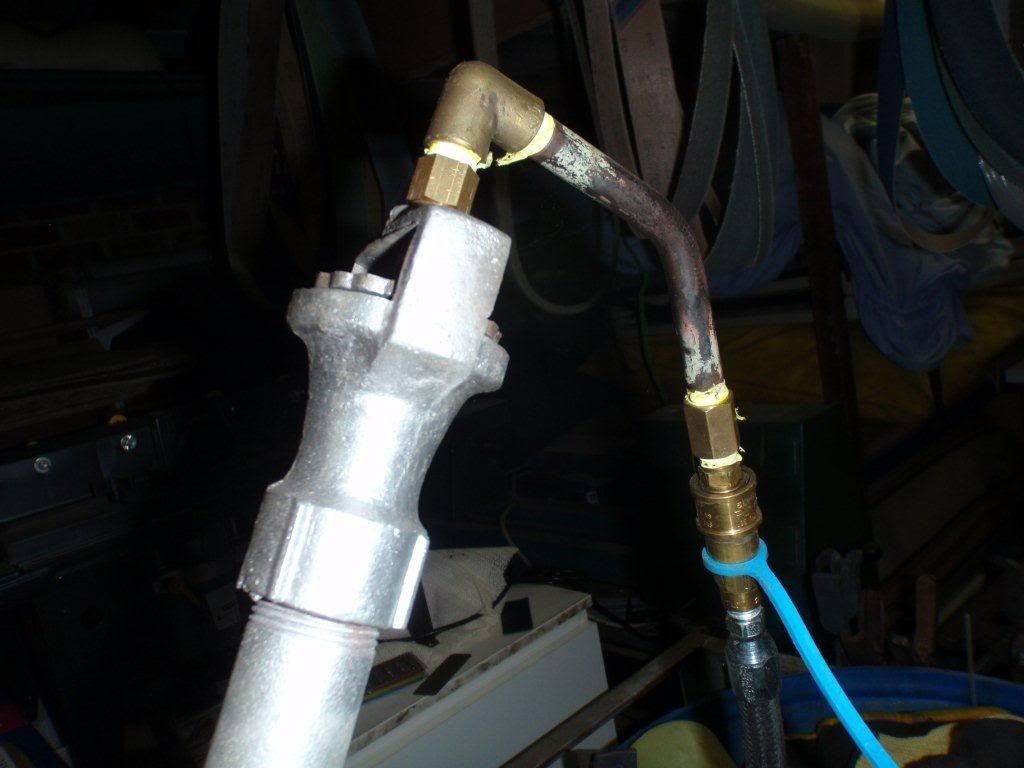
You can adjust the air as follows from closed to maximumand anywhere in between ;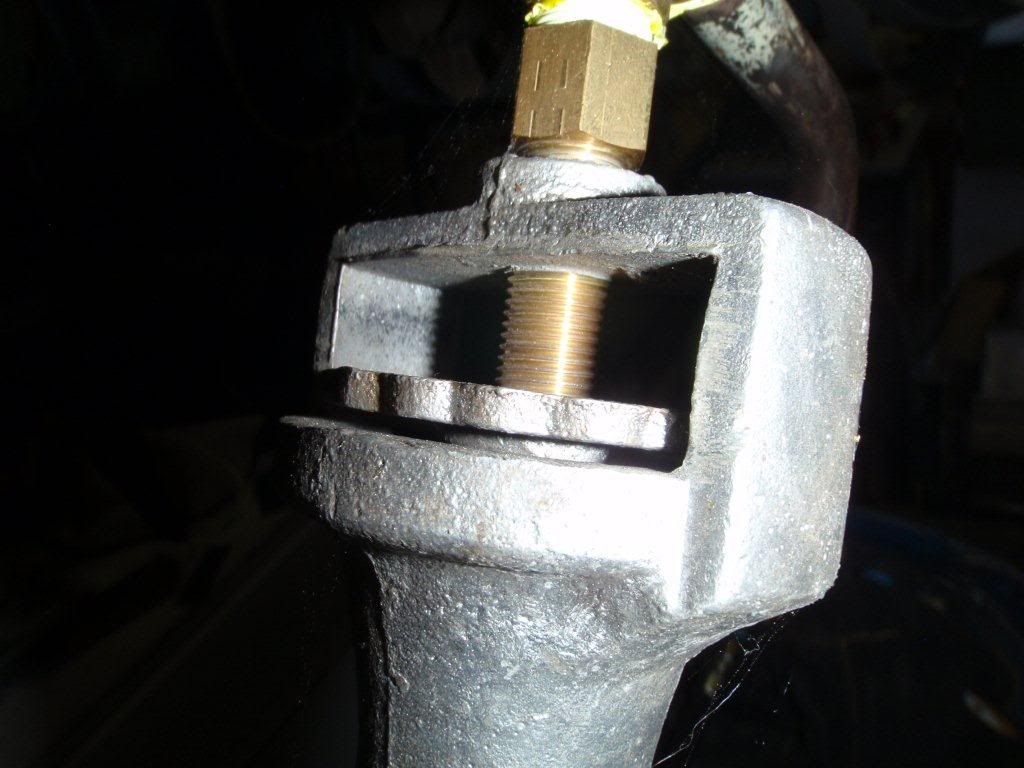
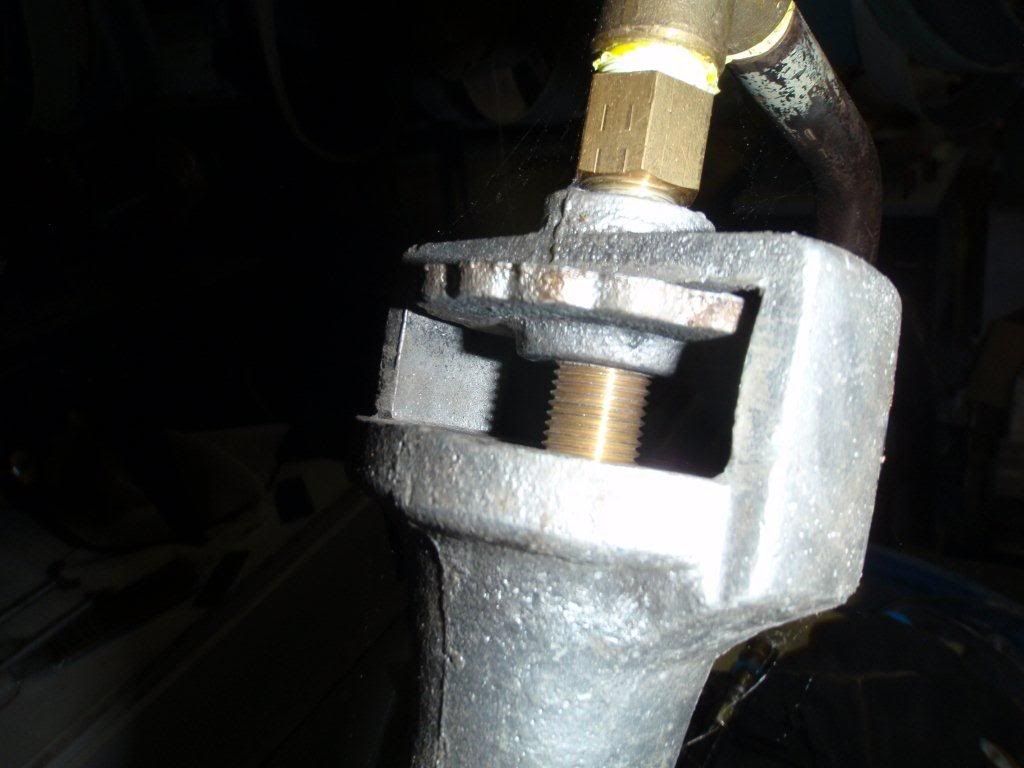
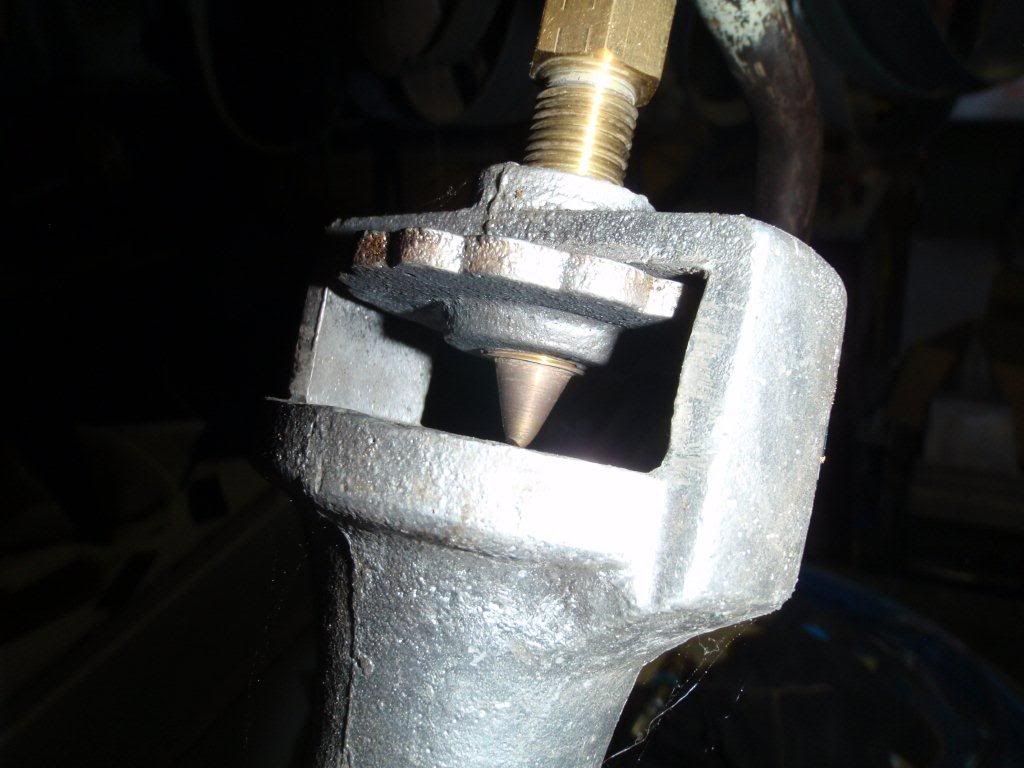

Lots of flexibility is what you want with air adjustment, If you cab adjust your pressure and hence your gas flow and velocity, and you can adjust your air you will have a very versatile burner.
Next lets talk about the jet. With this type of burner you need to use high pressure to get the super high temps, as I say above you need gas velocity and a good venturi to pull in the air.
Small jet, high pressure, will give better results than a large jet and low pressure despite the effective heat output being equal.
I modified my jet and it works heaps better... more on that another day. The jet size needs to be tuned to your burner and your forge, start small and work up. Use number drills and go up one at a time until you are happy.
Burner tube is just a bit of scrap 1" shedule 80 tube threaded at both ends. I tried a few different lengths. 12" was absolutely the best.
Next is the flame retention nozzle. This is the bit that seams to be a hot topic... I will simplify it for you. You need to step up from whatever your burner tube is to a bit bigger for a short length... pretty much anything that does that should work effectively in a forge.
I use a 3000LB steel 1" 1 1/2" steel reducing coupling. cheap, heavy duty and effective.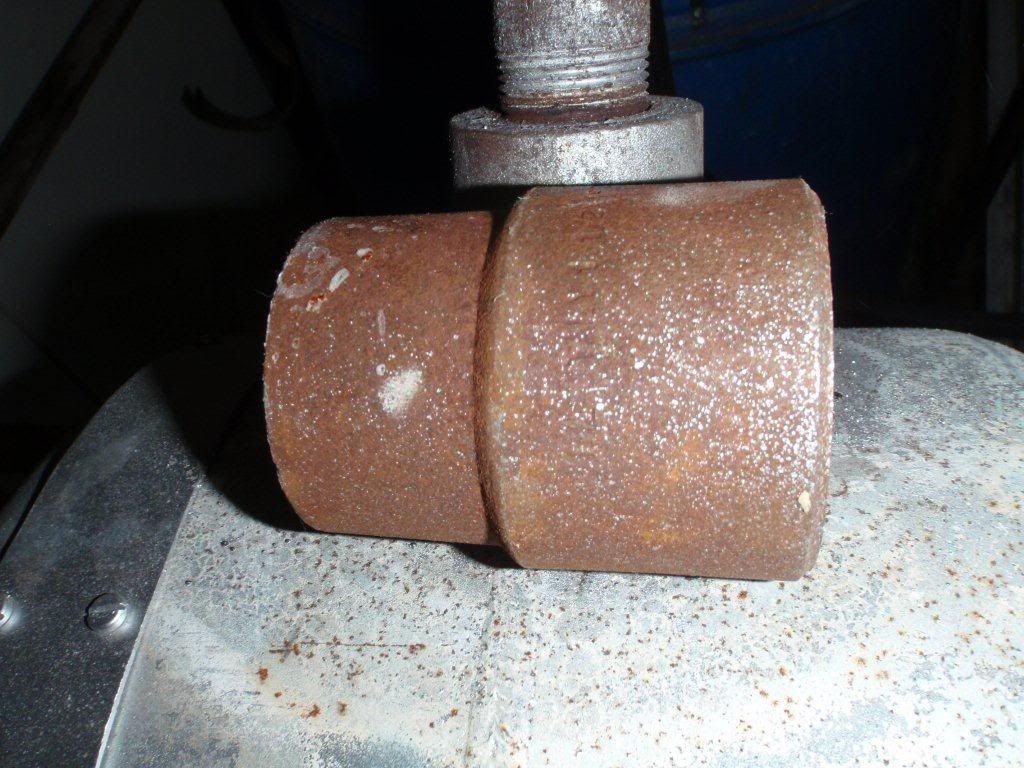
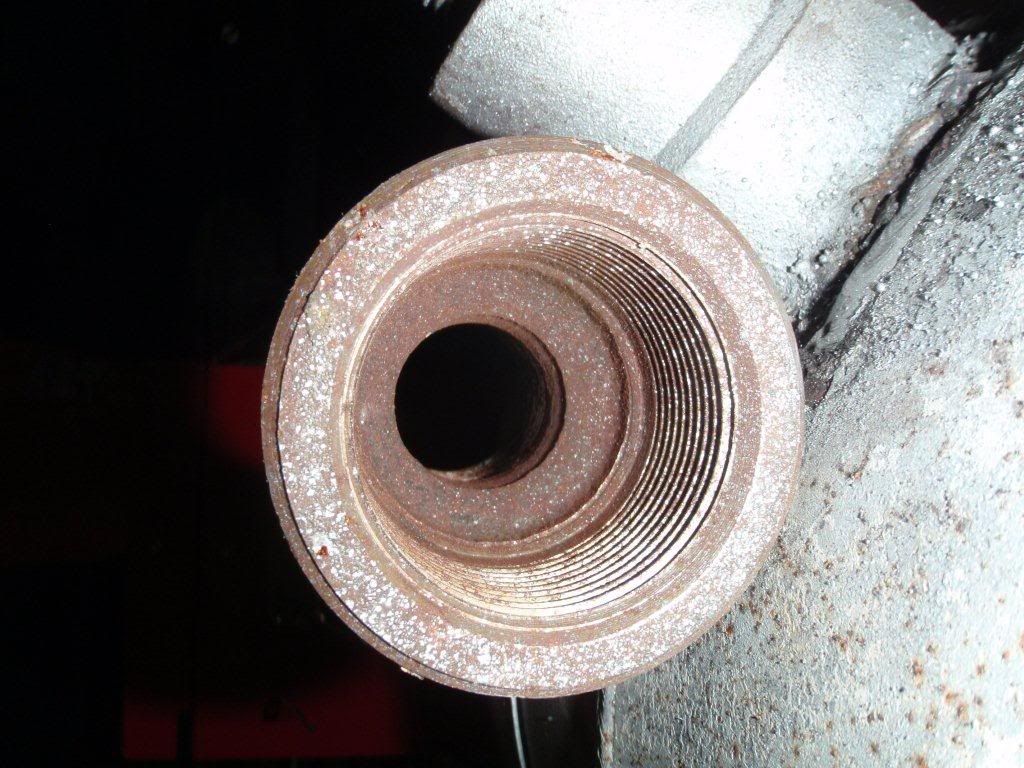
Too easy!
My forced air can melt steel
That thing is pretty cool... errr I mean Hot.... err I mean it looks good ;) -
Hi Corin
Mat from hot sunny and drying-out Brisbane. My question re- propane is many appliances have a small screw to disrupt the flow of propane and air, improving the mix. Would an atmospheric burner benefit from this or do the higher PSI's involved make this redundant?
Thank you.
Mate I feel for you guys... Our Queensland office is in Milton. I spent a few days up there helping mop up, what a mess. Here is a picture for those that don't know where Milton is... our office is in the black circle.
Now to Answer your question.... the screw you are referring to is a low cost easy method for low pressure burners normally found on BBQ burners and the like... for high pressure burners, lacking burner ports, like those we use for forges I would not think they would be ideal. I would be using a shutter that evenly blocks the air from all sides equally, thus allowing a constant flame shape... You will see in my forge pictures below what I use.
Hello Corin, welcome. Any chance of some pictures of your forge?
Sure! Here are some of the pics I took during its first relining after only 6 months the refractory was falling apart from too much heat too often, as you will see the floor was stuffed too from molten stuff...
First, Here is the whole forge, note I have changed the gas inlet since this picture was taken, note also the door reducer in place I will explain these later... It is made from an old 20# (9kg) cylinder.
Please don't just cut into any old propane tank... it may well erase your genes from the pool so to speak, which if you are that stupid is a good thing for the rest of us... get one that has been de-valved internally cleaned from your local gas merchant. It may cost you a few dollars, but not your life.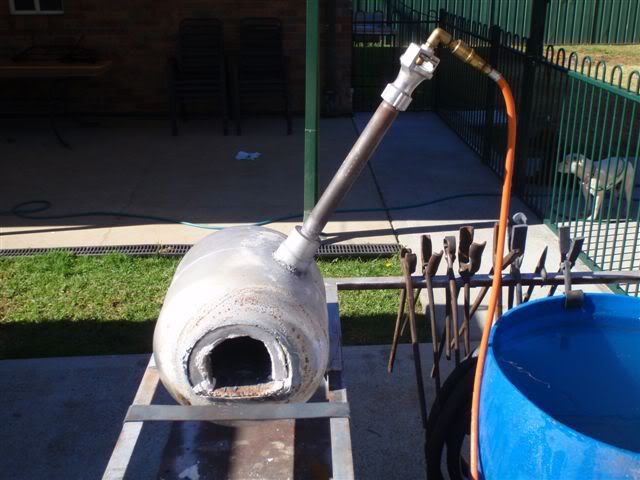
Next is a picture of the forge after a few months of abuse.. lol no regrets,
Next are a series of pictures of the rebuild they should be self explanatory. If you have questions please ask.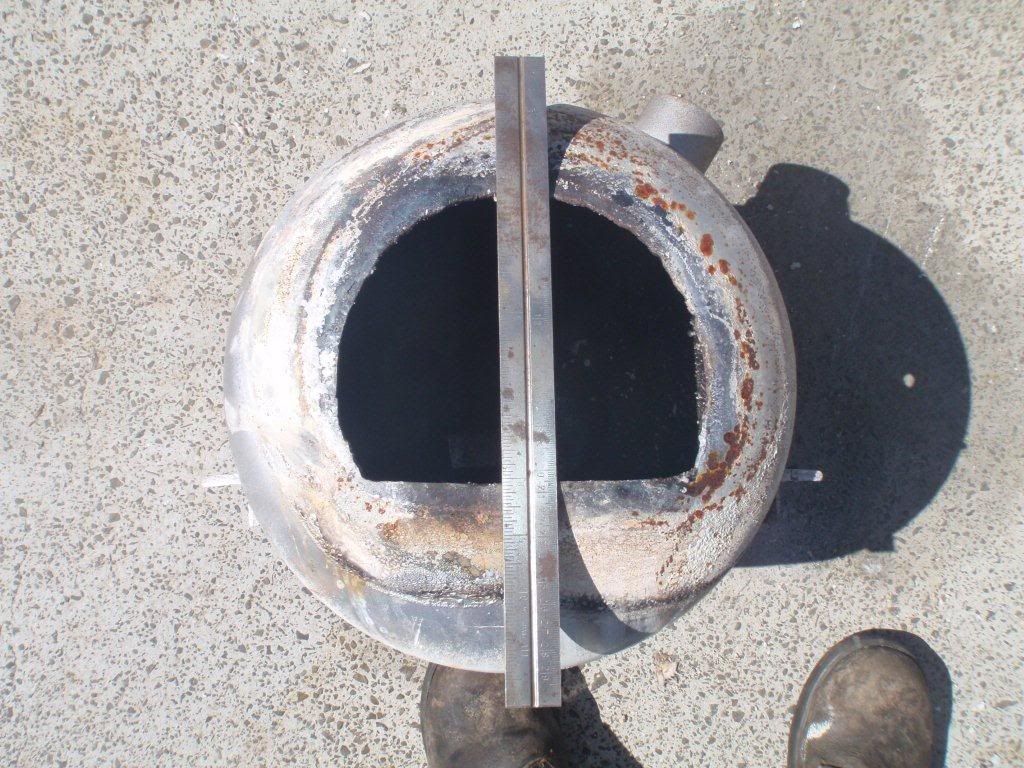
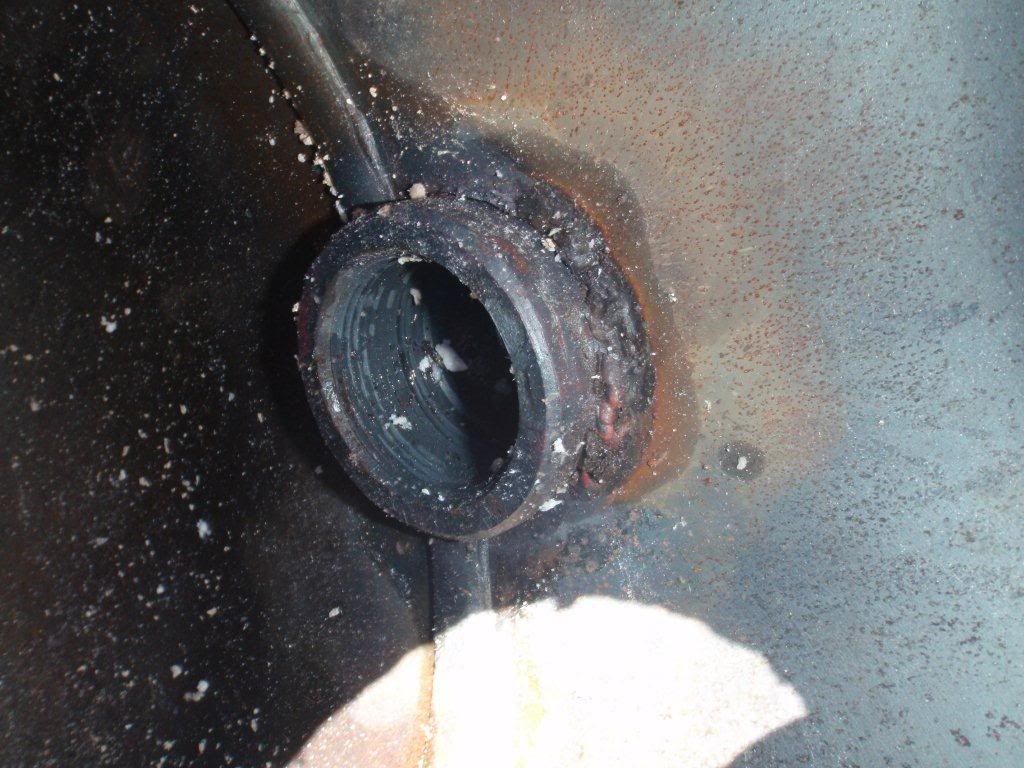
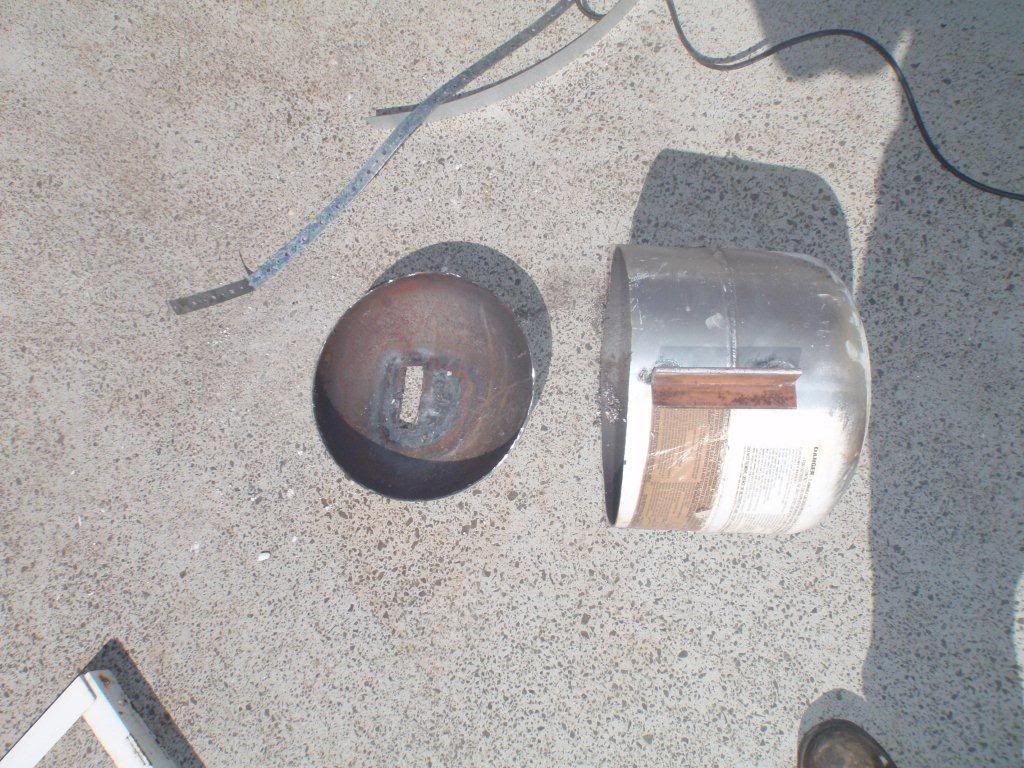
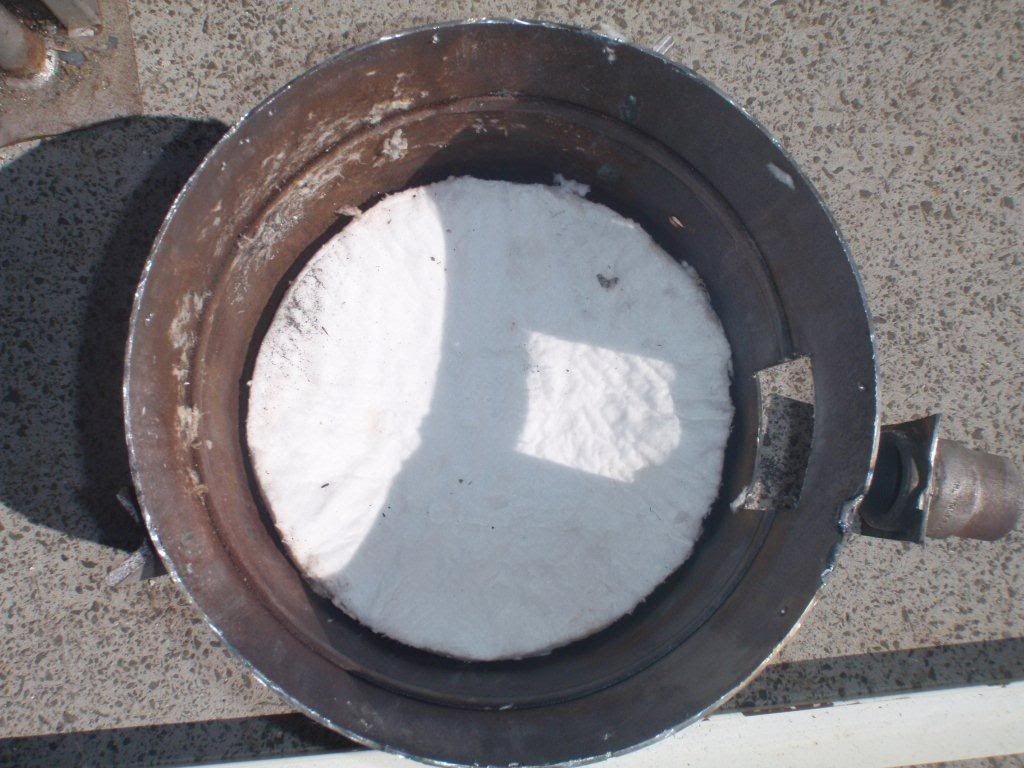
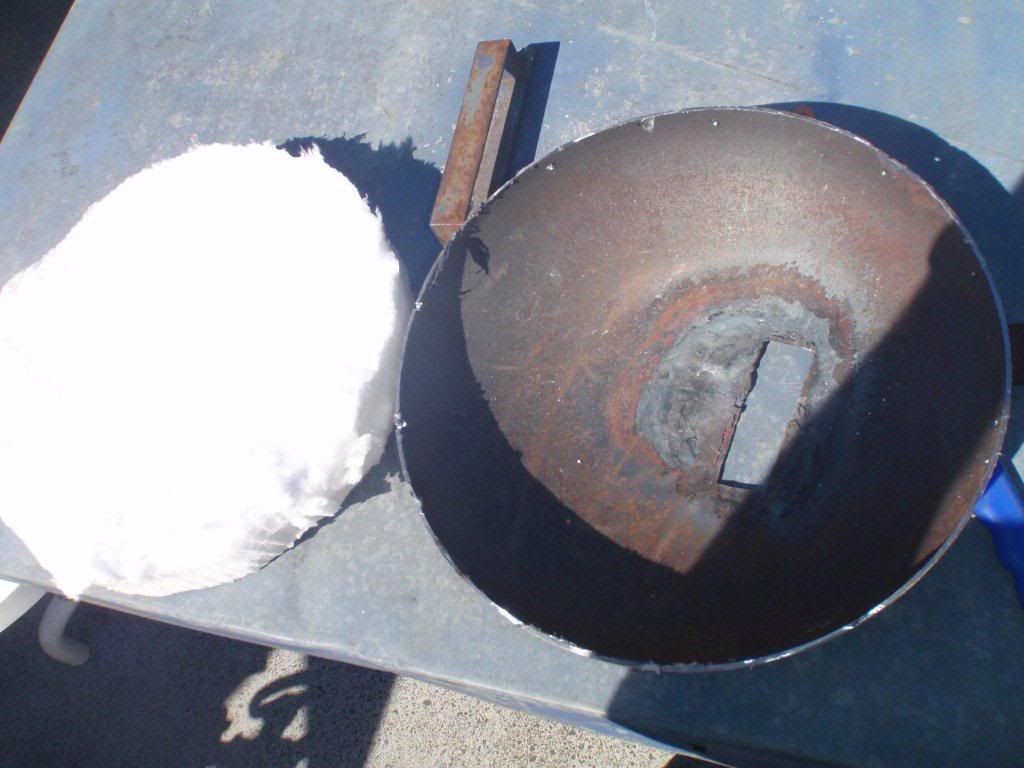
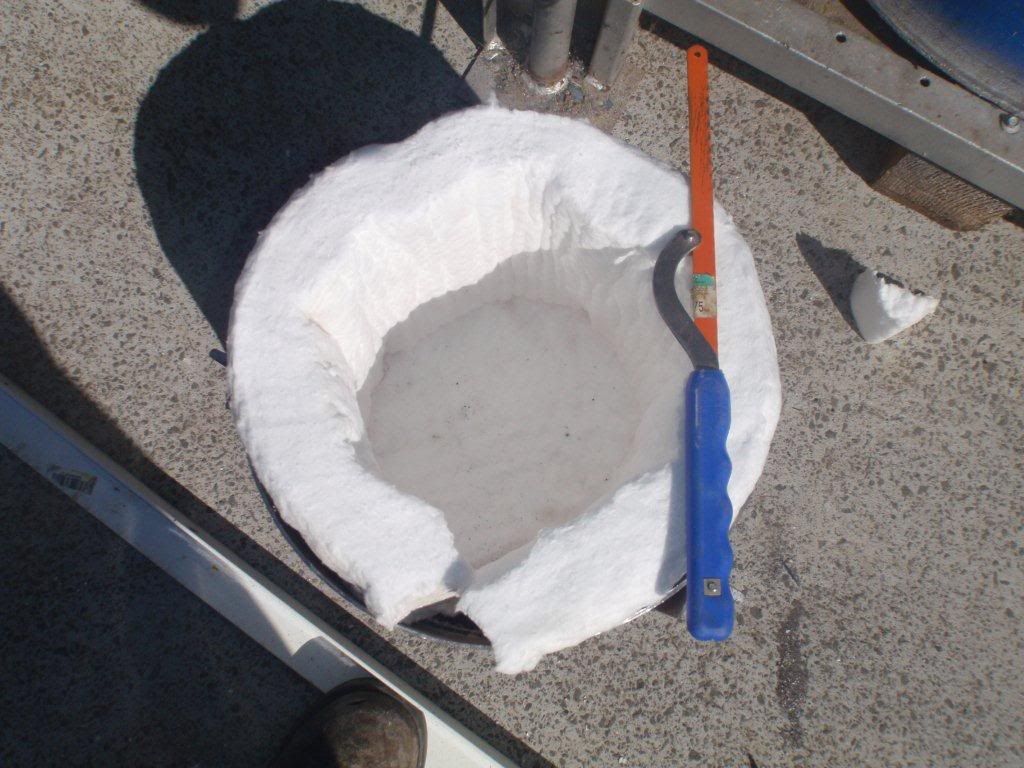

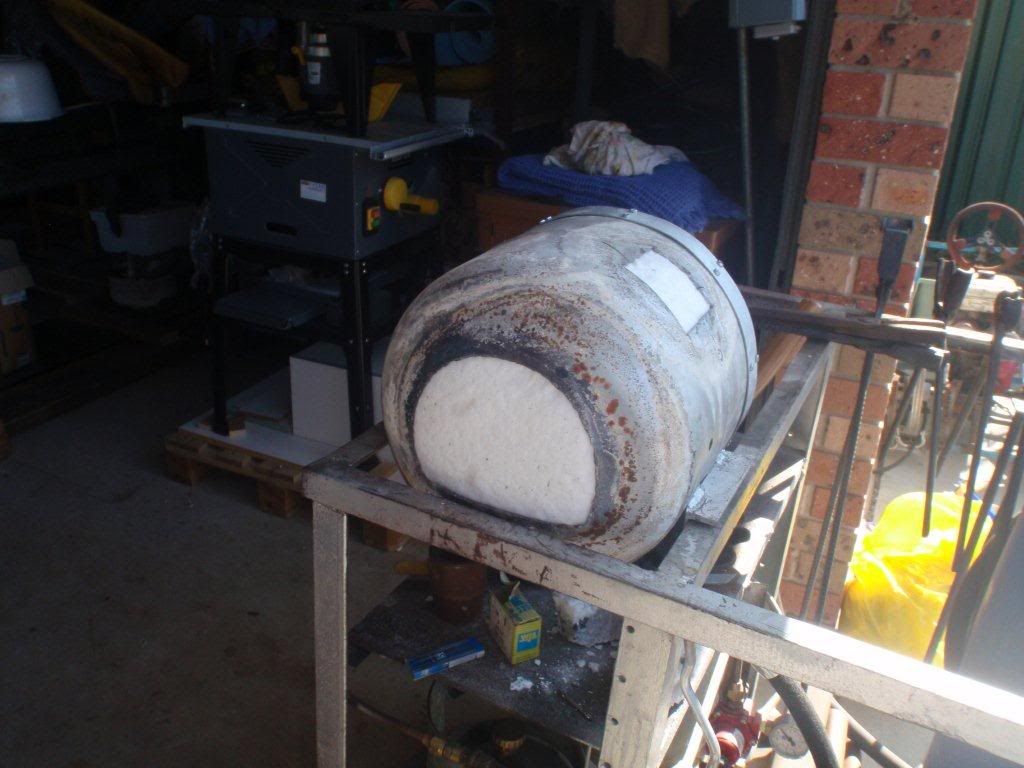
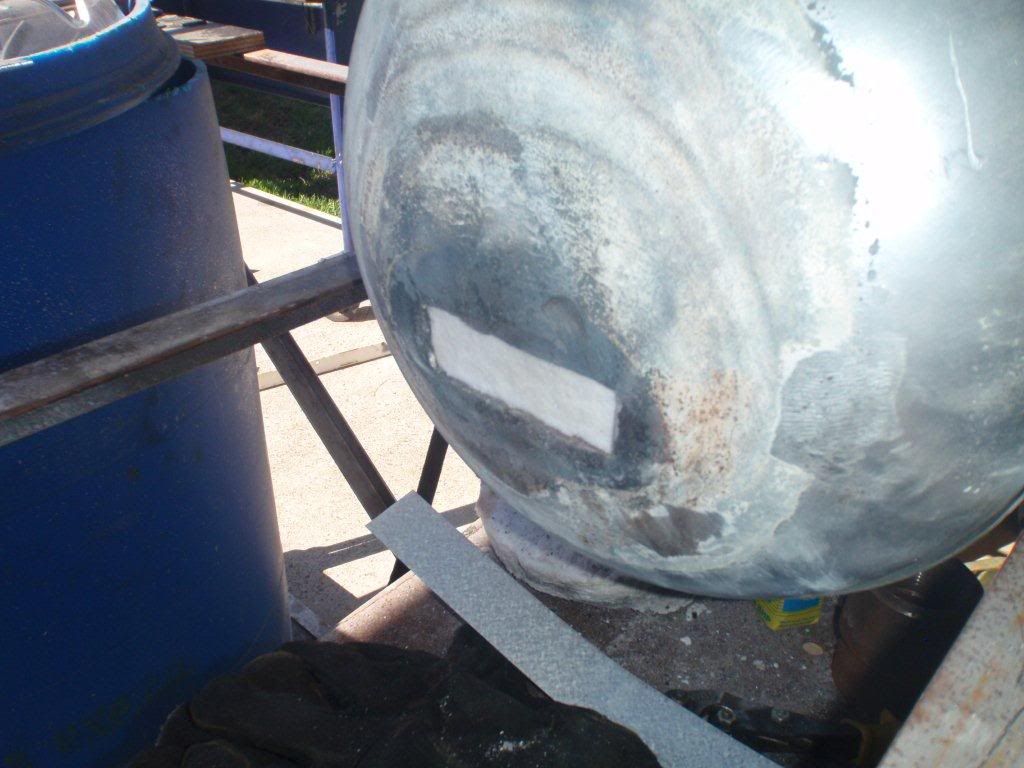
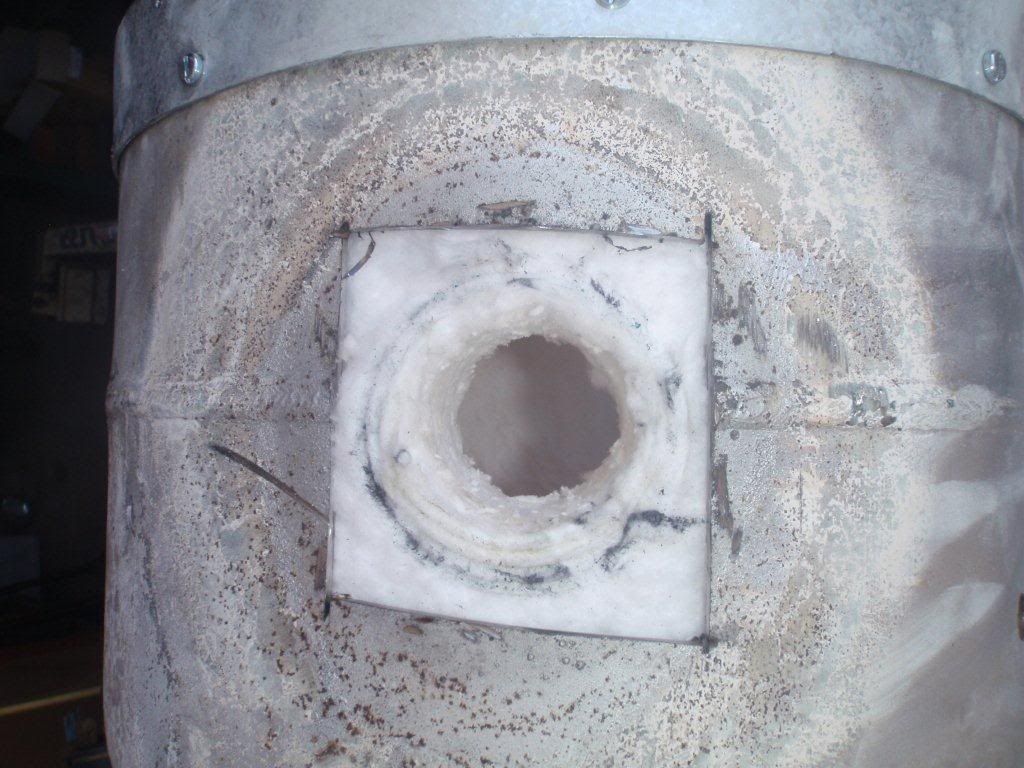

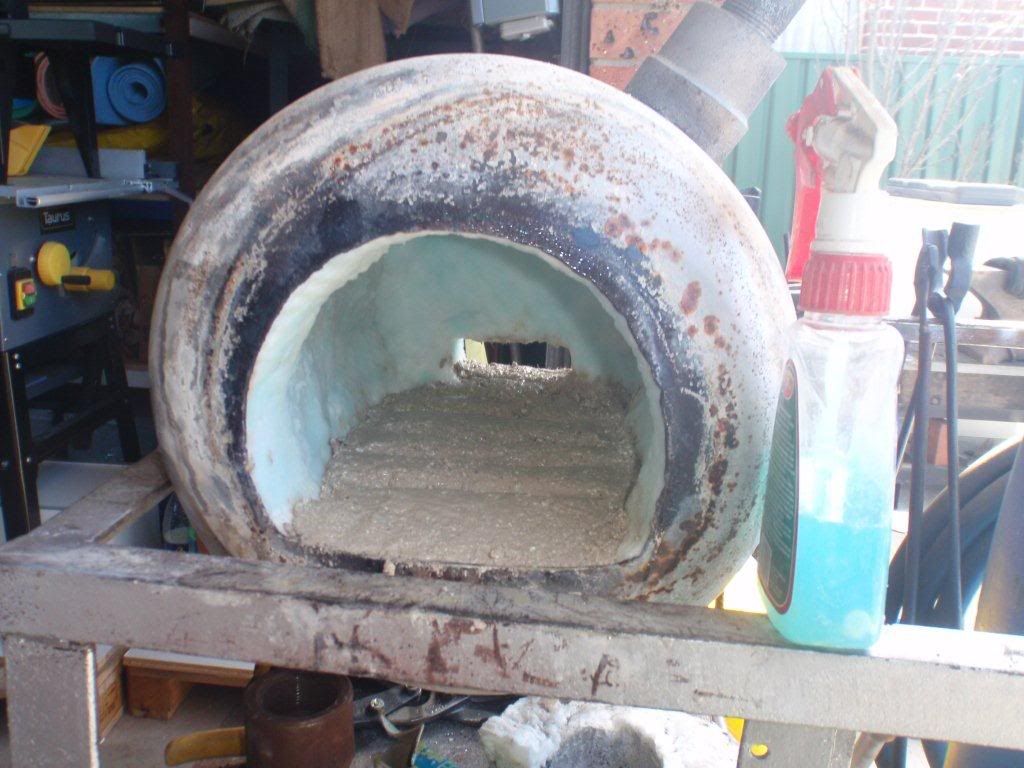
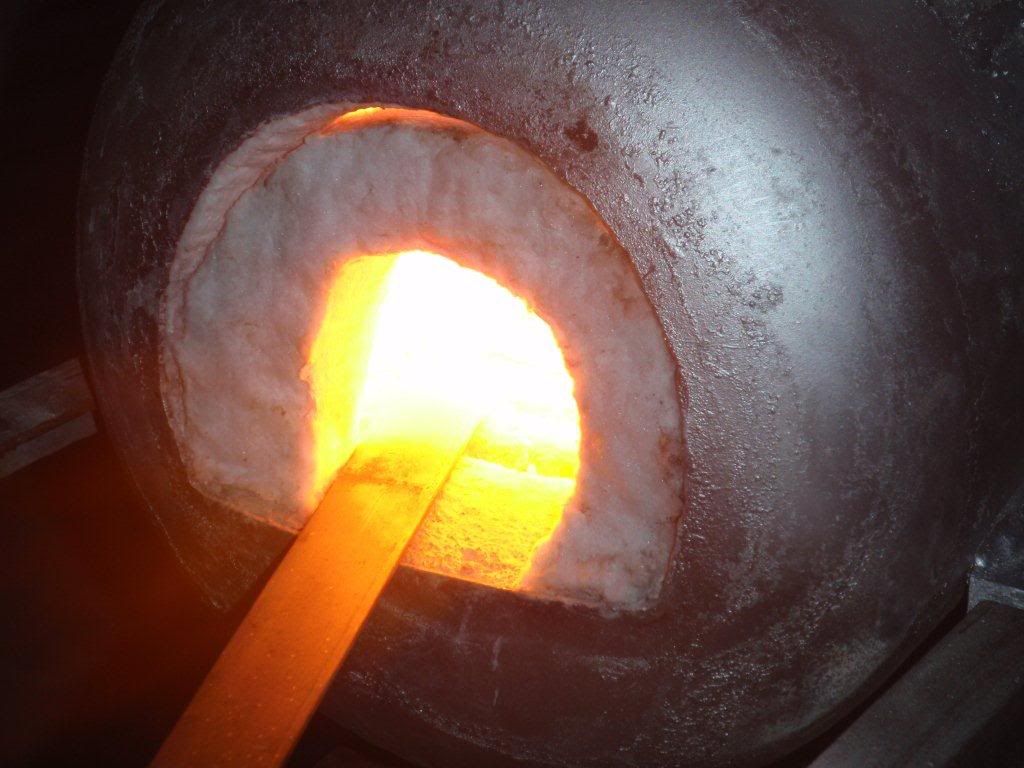
Ok I will stop there and see if this forum will handle so many pics....Sorry no idea yet, -
How can you melt steel with propane? I thought it doesn't get that hot. I have been using gas forges for 15 years.
Hi Mate,
Great question to kick off!
The maximum flame temperature for combustion for Propane is 3595°F This is in ideal conditions with oxygen. If you are burning air, as I do you are introducing Nitrogen (about 70% which is heated in the reaction and naturally cools the flame temperature. even with a super efficient burner you will not get this kind of temperature, but don't let that stop you. Almost as importantly you need to introduce and retain as much heat as possible within the forge. Steel melts at around 2500°F, it is not as hard as you think.
You need to consider two things.... Temperature, and Heat They are distinctly different animals. Think about it this way... a candle flame and a campfire flame will have approximately the same flame temperature, but a campfire will boil a large pot of water, where a candle will never get it up to temperature, as heat is lost from the pot as fast as you put it in. Your flame in your forge may have the temperature (try melting a piece of fine steel wire) but you may not have (or be able to retain) enough heat to melt anything bigger.
Their most certainly are home built forges out there normally with blowers, that get hot enough to smelt steel/iron.
This is a bad example, but it does show it is not that hard.
backyard foundry
Mine is different in as much as it uses a venturi and high gas pressure as opposed to a blower. Same principal.
I should add... these temperature destroy ceramic fiber wool, and molten steel destroys the floor of your forge... it is still fun though :D -
Hi People,
I have just joined this forum, and I am a newbie to blacksmithing having only a years experience.
I am not a Newbie to Propane. I have worked with Propane my whole life, I live and breath the stuff.
I am amazed by the miss information out there in blacksmith land, concerning this amazingly versatile and relatively safe energy source.
A little about me... I do not know everything about Propane, though I would like to . I do have access to one of the best libraries on the subject you will find anywhere in the world. If I don't know I will say so and probably direct you to somebody who will. If I say something you disagree with please say so, I am not perfect as I said, and it is important that all information shared is correct.
In my part of the world my trade is "Advanced LP Gasfitter", I do not work to American Standards such as NFPA 58, and whilst I own a copy I am not qualified to assist with your local legal requirements unless of course you are in NSW Australia. I am very familiar with all applicable codes in Australia, but not necessarily local enforcement and requirements.
I have repaired and helped with burner design on countless forges, but I am no expert in Burner design. I can trouble shoot, calculate your burners capacity, and assist in other areas. My own forge from cold start up takes about 2 1/2 minutes to melt 1/2" steel bar. I am pretty pleased with it. It is naturally inspirated (ie no blower).
If you have a question about propane, try me.
Lets give this a go, hopefully I will be able to assist.
Please note that I give my answers in good faith, as I believe through better understanding comes increased safety. In any matter involving Propane you should consult your local qualified tradespeople to ensure what you are doing, is both safe and complies with local legal requirements. All care taken no responsibility. -
Hi People,
Just a quick one by way of introduction,
I live near Sydney in Australia. I have had a fascination with all things metal since I was a child, and these days I focus on making knives... Mostly Scandinavian style, but I have my only little machine shop, as well as a few anvils and my little gas forge. I am always keen to see how others do things as for the most part I am self taught with a few weekend courses here and there... I am also happy to share what I have learnt.
Mostly I try and make my knives from scrap... Here are some pictures, the materials cost for both, including timber would be less than $5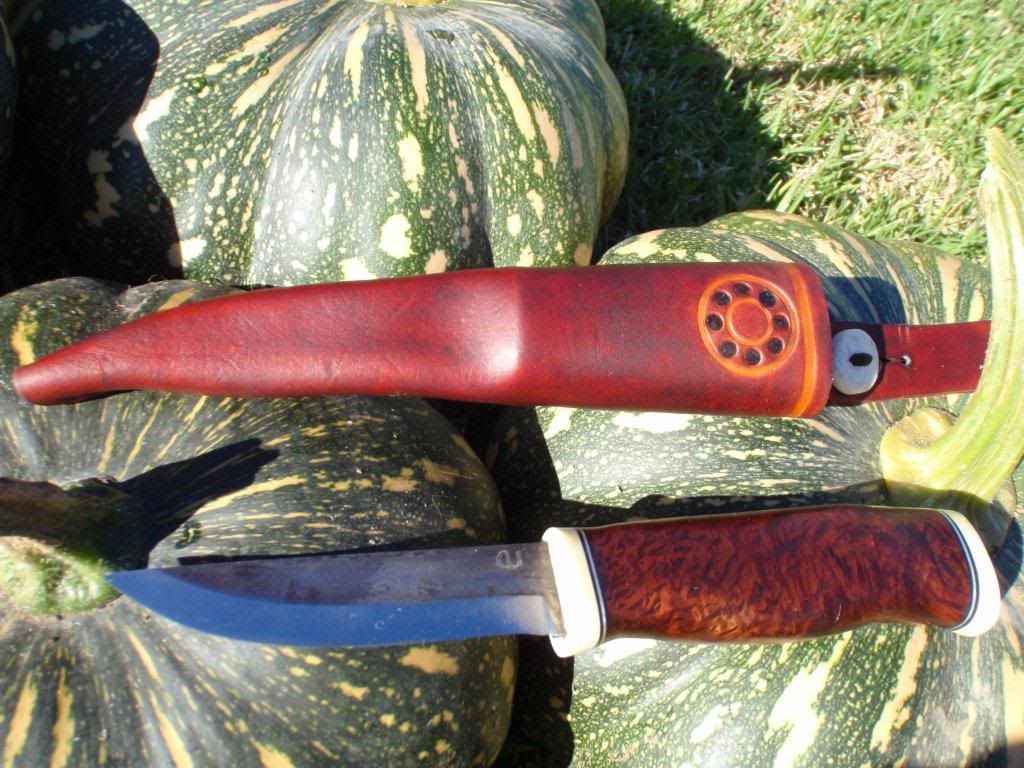



Second attempt
in Gas Forges
Posted
Regarding your mates forge, I may have sold him the gear... I have worked on a lot of forges!
Sorry mate I am not sure I understand which bit you are referring to when you say "hood". However I would not mess with the primary air though, because if that fails you will end up with no burner. You may as well put that burner aside for hand held heating work, and start again.
In your pictures it looks like you could undo the clamp and move the burner back from the hole and fire the flame in. This will definitely work, though your hole may be a little small, I still recommend you try it. I mentioned that this is what we do with Prawn Cookers, it is also what we do with Raku kilns with this type of burner, and they can get up to 1100 C +
Here is a Raku Kiln with this configuration
My link
and another
My link
and another
My link
This is a proven method with this style of burner, and if it is simple to move back it will save you a whole lot of issues if it works with your inlet hole. If not try firing into the bottom corner of your door.
Of course it may not work with what you have, but like I said you loose nothing giving it a quick go.
You may even find that by moving the burner in and out you will be able to adjust combustion.
Anyhow Let us know how you get on.